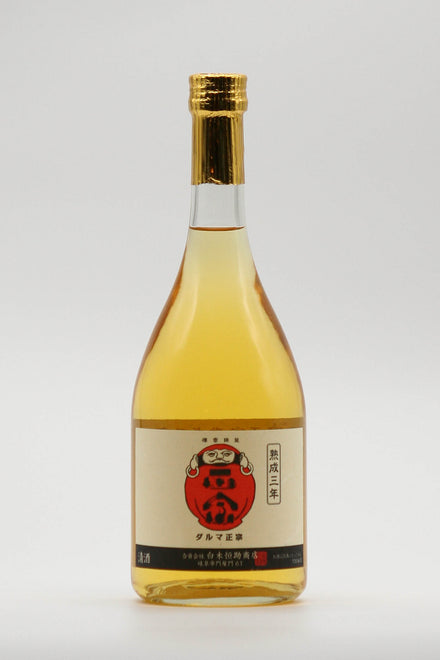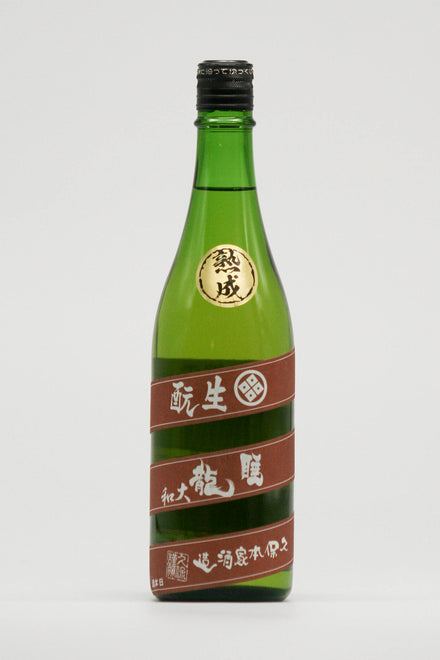
It has a glossy yellow color called teri, and a gentle but multi-layered aroma. By heating it at a higher temperature, the flavor, sharpness, and aroma harmonize, making it an even more appealing sake.
Junmai Gouriki H30BY Benten Musume
| Vintage | 2018 |
| Years aged | 5 years |
- 2010 or later
- All Products
- Golden yellow
- Less than 5,000 yen
- More attractive when warmed
- Throughout the meal
- 5-9 years
- Brewer:
- Alcohol:15 degrees
- Volume:720ml
Couldn't load pickup availability
[ Drinking alcohol under the age of 20 is prohibited by law. ]
This sake is made by fully fermenting the native variety ``Jyoku'', which is unique to Tottori Prefecture, with natural yeast. It is stored in tanks and aged in a clay-walled storehouse.You can enjoy it not only at room temperature, but also hot, hot, or chilled.
This alcohol goes well with a variety of dishes, from seafood to pickled vegetables and spices.
- about
-
Type 生酛 Rice polishing ratio 75% Yeast type - (No yeast added) Ingredients/raw materials rice, rice malt Rice type powerful Origin of rice Wakasa Town, Tottori Prefecture Toji(Brew Master) Yoshiyuki Nakajima Assemblage 無
- Recommended occasions/temperature
-
- How to store
-
- Delivery dates and charges
-

Tasting comments
-
Nobuhiro Ueno
(Mature and Warm Bar Master / Toki SAKE Association Executive Director)(chilled)
A gentle aged aroma, sotolon (smells like maple syrup), nutty burnt nuances, and a hint of soy sauce.
As the temperature rises in the mouth, it develops an apricot-like aroma and sweetness. It has just the right amount of flavor and an astringent aftertaste that is pleasant.
(warm)
Aroma: Mild, aged scent (soy sauce type).
In the mouth, it smells like alcohol with a little smoke. As the temperature drops, the aroma becomes sweeter like dried fruit.
If you raise the temperature, the flavor will spread and the sharpness will increase. It's also delicious hot and cold.
-
Hidekazu Ishiwata
(Former National Tax Bureau Chief Appraiser)(chilled)
First of all, it has a shiny golden yellow appearance called teri. The top has hints of sotolon, nuts, and chocolate.
The aroma is mild, and the refined aged aroma spreads throughout the mouth.
Beautiful but full, round flavor.
(warm)
At the top, it has a mature aroma with a hint of sulfur.
It has a sweet, burnt aroma with a slightly bitter taste.
Smooth sweetness. Impressions of caramel and chocolate. Sharp and acidic.
-
Akiko Toda
(Director of ITTEKI, Japan Sake and Meat Research Institute)(chilled)
I am fascinated by the beautiful bright yellow color.
The aroma is subtle, with the scent of brown rice and nuts.
A relaxing taste with a gentle balance of flavors. You want to enjoy it as the temperature gradually drops, keeping it extremely hot at 55 to 60 degrees.
(warm)
A gentle scent reminiscent of soy sauce and pickles. The taste is very soft and harmonious. A temperature of around 50℃ gives the best impression.
I would like to pair it with simple robatayaki such as grilled rice balls and grilled miso. -
Yuji Yamauchi
(Yushima Tenjinshita Sushi Hatsu 4th generation / 1st JSA SAKE DIPLOMA competition winner)(chilled)
It has a more grain-like texture (the protein on the outside of the rice) and is satisfying, with a wide stem that can be enjoyed even at room temperature. In the second half, it becomes sharp and shows the wide range of temperatures at which it can be served, both at room temperature and warmed.
(warm)
The depth of ripening of sotolon and furfural, the sweetness of the rice, and the flavor come to the fore.
Although the center of gravity is a little low, it is good for nanbanzuke etc.
The image rises to the top at 55℃. The sweetness and aroma are balanced, and you can feel the depth. It has a soy sauce-like aroma. Takwan has an impression of bonito flakes.
Brewer
- Choosing a selection results in a full page refresh.
- Opens in a new window.



